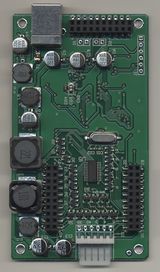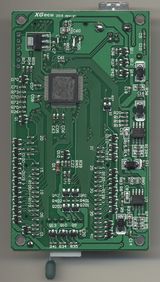TL866 II PLUS
The TL866 II PLUS is NOT compatible with the TL866 A / TL866 CS models. The microcontroller has been changed from a PIC18 to a PIC24F and there are other significant schematic changes. The plastic enclosure for the TL866 II PLUS is identical to the TL866A / TL866CS.
Hardware
The TL866II PLUS is driven by a Microchip PIC24FJ256GB110 microcontroller which connects directly to the USB.
Pinouts
| VPP | VDD | GND | IO | IO | GND | VDD | VPP | |||
|---|---|---|---|---|---|---|---|---|---|---|
| RF1 | VDD | GND | RD10 | 01 | 40 | RD0 | GND | VDD | VPP | |
| RF0 | VDD | GND | RD9 | 02 | 39 | RD11 | GND | VDD | VPP | |
| RD7 | VDD | GND | RD8 | 03 | 38 | RD1 | GND | VDD | VPP | |
| RD6 | VDD | GND | RF8 | 04 | 37 | RD2 | GND | VDD | VPP | |
| RD13 | VDD | GND | RF2 | 05 | 36 | RD3 | GND | VDD | VPP | |
| VPP | VDD | GND | RF5 | 06 | 35 | RD4 | GND | VDD | VPP | |
| VPP | VDD | GND | RF4 | 07 | 34 | RD5 | GND | VDD | VPP | |
| VPP | VDD | GND | RD15 | 08 | 33 | RG14 | GND | VDD | VPP | |
| VPP | VDD | GND | RD14 | 09 | 32 | RG12 | GND | VDD | VPP | |
| VPP | VDD | GND | RA1 | 10 | 31 | RG13 | GND | VDD | VPP | |
| VDD | GND | RA15 | 11 | 30 | RG15 | GND | VDD | VPP | ||
| VDD | GND | RA14 | 12 | 29 | RE7 | GND | VDD | |||
| VDD | GND | RE0 | 13 | 28 | RE6 | GND | VDD | |||
| VDD | GND | RE1 | 14 | 27 | RE5 | GND | VDD | |||
| VDD | GND | RE2 | 15 | 26 | RE4 | GND | VDD | |||
| VDD | GND | RE9 | 16 | 25 | RE3 | GND | VDD | |||
| RE8 | 17 | 24 | RD12 | |||||||
| RF12 | 18 | 23 | RA5 | |||||||
| RF13 | 19 | 22 | RA4 | |||||||
| RB2 | RA2 | 20 | 21 | RA3 | RB3 |
The primary interface to the target device is a 40 pin ZIF (zero insertion force) socket. Digital IO at LVCMOS3.3 levels is supported direct to the MCU on every pin. Inputs above +3.3V will be clamped. The VDD bus can be switched to pins 1-16 and 25-40. The VPP bus can be switched to pins 1-10 and 30-40. The ground bus can be switched to pins 1-16, 20, 21, and 25-40.
Original research
Photos
TL866 II PLUS photos
Photos of a TL866 II PLUS bought April 2018 from eBay seller goldenchipset.
Red and yellow LEDs were desoldered from mainboard to allow separation of the two PCBs.



